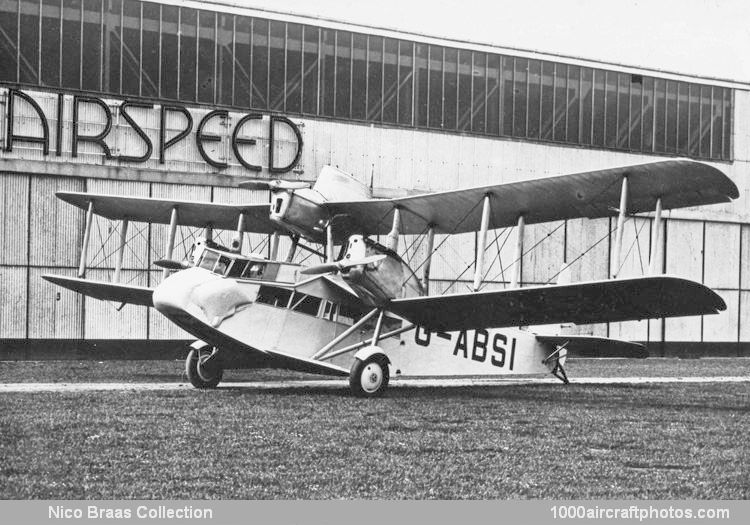The newest, most interesting and unorthodox aeroplane that day was the Airspeed Ferry prototype G-ABSI named 'Youth of Britain II'. Built to Sir Alan's specification by A.H. Tiltman and N.S. Norway in the newly established Airspeed factory at York, it was a large three-engined biplane of wooden construction with plywood-covered fuselage and fabric wings. The blister on the nose was a fairing which covered exterior control gear.
Although a biplane specifically designed for short-range pleasure flying and having an outstanding small field performance, its three engines and roomy cabin for ten passengers made it virtually an airliner in miniature. No more suitable aircraft could have been designed for firmly establishing in the minds of those making their first flights the safety, comfort and speed of the airlines. This form of promotion was, of course, the underlying motive of National Aviation Day's activities.
The display went on tour, and later in the year was joined by a second Ferry G-ABSJ (c/n 5), 'Youth of Britain III', and thereafter their silver and green became a familiar sight at no fewer than 200 towns and villages visited in all parts of the UK. The 1933 tour was no less popular than the first, and with G-ABSJ renamed 'Youth of Africa' the Ferries continued faithfully to carry their eleven-man loads out of little fields on the total of 360 hp (or only 36 hp per paying passenger) given by one 120 hp Gipsy III inverted engine in the top center section and two upright 120 hp Gipsy IIs mounted on the lower mainplanes.
G-ABSJ was eventually disposed of in favor of the Handley Page Clive G-ABYX, and was sold by R.K. Dundas Ltd. to the Himalaya Air Transport and Survey Co. Ltd., and ferried out to India by the late F/Lt. Brembridge in September 1934. On arrival it was christened 'Dragoman' and used for conveying pilgrims from Hardwar to Badrinath en route to a holy shrine high in the Himalayas. In 1936, however, the wooden fuselage fell prey to the ravages of the white ant and the aircraft was written off.
In 1933, the second and final pair of the type, G-ACBT (c/n 6) and G-ACFB (c/n 9), had been disposed of to John Sword, a bus operator of wide experience and managing director of Midland and Scottish Air Ferries Ltd. The two white Ferries, with their smart red trimmings, flew for two seasons on the Company's services from Renfrew to Campbelltown, to Belfast and to Speke. Here, by mutual arrangement, they connected with Hillman's Dragons, thus giving a through trunk service to the South of England. With the death of John Sword, however, the firm closed down at the end of 1934 and the Ferries were put up for sale. In 1939 G-ACBT still languished at Renfrew, its stable-mate having been sold in April 1936 to C.W.A. Scott's Air Display and sent to Hanworth for overhaul. Here it joined the prototype, acquired when National Aviation Day Displays came to an end in 1935.
After a season in a new all-red color scheme, G-ABSI and G-ACFB became the property in the following November of Air Publicity Ltd. of Heston, and during the winter the varied assortment of ageing Gipsies was removed, and in 1937 the Ferries reappeared with three new inverted 130 hp Gipsy Major engines. In this form they continued their joy-riding careers until the end of the following season. In 1939 the prototype was bought by Portsmouth, Southsea and Isle of Wight Aviation Ltd., but saw little service on their Isle of Wight shuttle, the annual CofA overhaul not taking place until December 1939, well after the outbreak of war, and in 1940 it was taken over by the RAF. The G-ACFB was allowed to lapse into disuse after the CofA expired on November 21, 1938, and remained picketed at Heston until dismantled and taken by road to an Air Training Corps Squadron at Stoke-on-Trent in 1941."
